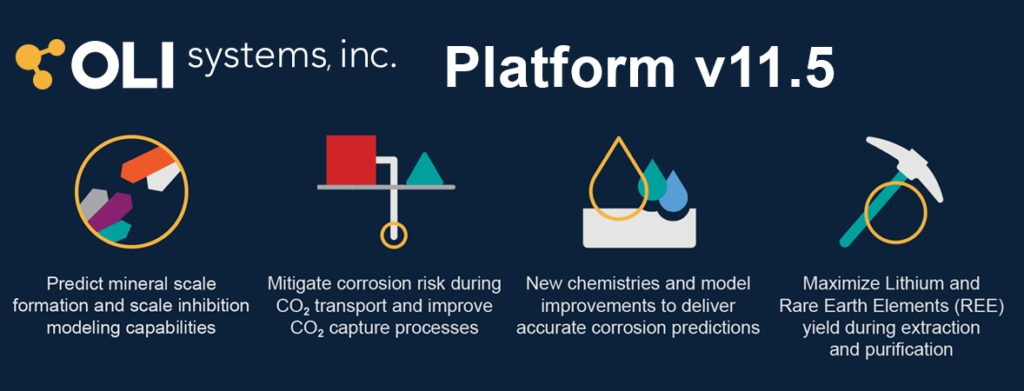OLI Systems Platform v11.5 helps to mitigate operations risk due to mineral scaling and corrosion, enhance sustainability with more efficient CO2 transport & capture and maximize yields and purity in processing of rare earth elements. Available to download now.
OLI Systems understands the challenges that the increasing need to improve operational efficiencies and drive improved environmental sustainability across all industrial sectors bring. These challenges require OLI to continuously enhance our predictive insights in water chemistry applications that help to predict phenomena such as corrosion, scaling, fouling, chemical equilibria, phase changes and toxic contamination.
For the last five decades OLI’s skilled subject matter experts have drawn upon their deep industry-specific domain expertise to deliver a portfolio of electrolyte modeling software solutions and consulting services that presents OLI as a trusted advisor for a complex range of industrial water chemistry applications. Over 500 global clients use OLI’s solutions to design and operate industrial plants and equipment more efficiently and effectively by optimizing materials selection, improving equipment reliability, enhancing environmental sustainability, and mitigating operations risk.
What’s new in version 11.5

Analyze mineral scaling risk and optimize chemical treatment
Formation of mineral scaling can hinder fluid flow and can jeopardize upstream production; causing production losses and inability to meet demand, this has a high impact on operation costs in the oil and gas industry.
V11.5 includes chemistries to predict nucleation of calcite, barite, gypsum and celestite, the most common mineral scales. The nucleation model accurately calculates the induction time for these minerals in the presence or absence of common chemical inhibitors in brine, oil & gas fluids to help analyze scaling risks in upstream production and wastewater treatment.
Five new scale inhibitor (DTPMP, EDTMP, PBTC, MLA, PMLA) chemistries and kinetics with the common scaling minerals are included and cover a majority of the scale management applications in the industry.
These capabilities help to evaluate how scaling can be prevented with the minimal use of chemical inhibitors, helping to optimize chemical treatment programs and accelerate operations efficiency in oil and gas production and water/wastewater treatment.
More reliable CO2 transport, capture and storage
OLI Systems continued investment in R&D has allowed us to improve our capabilities in a wide range of chemistries. A key focus of OLI’s innovation in v11.5 has been on addressing the complicated issues that surround carbon capture, utilization, and storage (CCUS). The OLI platform v11.5 is the only simulation software in the market that can successfully predict corrosion behavior in pipelines and storage containers that transport CO2. To find out more details about OLI’s capabilities to simulate CCUS processes, please read Leslie Millers recent blog post here.
Enhanced corrosion prediction
In this release the existing iron oxide and hydroxide chemistries have been expanded to enable the accurate prediction of iron chemistry in steam generating plants to prevent flow accelerated corrosion (FAC) of carbon steel. Updates to the nitric acid chemistries enable better prediction of thermophysical properties of this important chemical. V11.5 also includes updates to the corrosion rate predictions for Alloy 304 in water, a unique capability of OLI. Also, new boron chemistry and related lithium hydroxide chemistry improvements deliver more accurate corrosion predictions in nuclear energy reactors.
Improved yields and achieve higher purity levels in rare earth elements mining
OLI’s specialized rare earth (REE) database has been supplemented with new REE chlorides and sulfates in alcohols, REE oxalates and a comprehensive set of REE fluorides in v11.5. These new species enable better understanding of the phase behavior of these species allowing for evaluation of better reagent ratios that can maximize the efficiency of REE production and recycling, thus leading to cost savings.
Software enhancements
This release updates OLI Studio, OLI Flowsheet: ESP and OLI Alliance Engine Windows editions to operate in 64-bit, resulting in an increased performance when executing calculations. The default thermodynamic framework for OLI Studio and OLI Flowsheet: ESP has also been set to MSE framework which delivers improved simulations.
Accelerate digital transformation
The new capabilities in v11.5 can be leveraged by OLI’s Cloud Platform (Cloud APIs and Cloud AppBuilder) to expand access to all stakeholders regardless of expertise in electrolyte chemistry, these capabilities are ideal for real-time monitoring and automation to improve operational performance in digital transformation projects.
Available to download now
OLI Systems platform version 11.5 is now available to download for existing users. If you have any questions on the update, please contact your account manager for support.
For more information on OLI Systems solutions or to request a demo of the latest updates please leave your details here.

